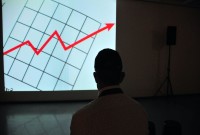- Home
- Business Processes
- Industry Knowledge
- Aerospace Industry
- Automotive Industry
- Banking Domain
- BFSI Industry
- Consumer/ FMCG Industry
- Chemicals Industry
- Engineering & Construction
- Energy Industry
- Education Domain
- Finance Domain
- Hospitality Domain
- Healthcare Industry
- Insurance Domain
- Retail Industry
- Travel and Tourism Domain
- Telecom Industry
- Leadership Skills
- eLearning
- Home
- Leadership Skills
- Leadership & Management
- Taylor’s Scientific Management
Taylor’s Scientific Management
Taylor’s theory of scientific management aimed at improving economic efficiency and labor productivity. Taylor had a simple view that money motivated people at work. He felt that workers should get a fair day's pay for a fair day's work, and that pay should be linked to the amount produced. He introduced the differential piece rate system, of paying wages to the workers.
The industrial revolution provided the impetus for developing various new approaches to increase the productivity and efficiency of the workers. Taylor during 1856 and 1915 propounded that there is a need for developing a scientific way of performing each job and workers should be trained to perform that particular job in a scientific way. Harmonious relations should be developed between management and workers to ensure that the job is performed in the desired way. This led to the management theory known as principles of scientific management.
This theory is a Classical management theory that is based on the belief that workers only have physical and economic needs and prescribes specialization of labor. Classical theories recommend centralized leadership and decision-making and focus on profit maximization. Three streams of classical management theory are - Bureaucracy (Weber), Administrative Theory (Fayol), and Scientific Management (Taylor).
Principles of Scientific Management
Four Principles of Scientific Management are:
- Time and motion study: Develop a science for each element of the job to replace the old rule of the methods. Study the way jobs are performed and find new ways to do them.
- Training: Scientifically select employees and then train them to do the job as described in step-1. Teach, train, and develop the workman with improved methods of doing work. Codify the new methods into rules.
- Supervision: Interest of employer & employees should be fully harmonized so as to secure mutually understanding relations between them. Supervise employees to make sure they follow the prescribed methods for performing their jobs. Continue to plan the work but use workers to actually get the work done.
- Differential Rewards: Establish fair levels of performance and pay a premium for higher performance.
Taylor's scientific approach resulted in a piece-rate incentive system, and the time-and-motion study.
Taylor's Differential Piece Rate Plan:
Taylor felt that the wage system was one of the major reasons for soldiering. To resolve this problem, he advocated the use of a piece-rate incentive system. The aim of this system was to reward the workers who produced the maximum out-put. The system proposed:
- If Efficiency is greater than the defined Standard then workers should be paid 120 % of the Normal Piece Rate.
- If Efficiency is less than standard then workers should be paid 80% of the Normal Piece Rate.
Time and Motion Study:
Taylor also tried to determine the best way to perform each and every job. To achieve this objective, he introduced a method called time-and-Motion study. In this method, a large production job was broken down into various small tasks or motions and unnecessary motions were removed to find out the best way of doing a job. A motion study involves finding out the best sequence and the minimum number of motions needed to complete a task.
After Taylor, Frank and Lillian Gilbreth made numerous contributions to the concepts of scientific management. Frank and Lillian were mainly involved in exploring new ways of eliminating unnecessary motions and reducing worker fatigue.
- Frank Gilbreth (1868-1924) is considered the "father of motion study"
- Lillian Gilbreth (1878-1972) contributed to studies pertaining to motion.
Limitations of Scientific Management:
Although Scientific Management Theory has been instrumental in providing various valuable insights into the development of management thought. In spite of the numerous contributions made by scientific theory, given below are the few limitations:
- The principles of scientific management focus on solutions from an engineering point of view rather than a managerial point of view
- The entire theory is based on the assumption that humans are rational and motivated primarily by the desire for material gain. It overlooks the social and emotional needs of workers and overstressed their economic and physical needs
- The human desire for self-actualization and job-satisfaction (working conditions, job content, etc.) is ignored by the theory
Suggested Reading and Resources
Related Links
You May Also Like
-
Management Principles by Fayol
Henri Fayol (1849-1925), a French industrialist and a prominent European management theorist, developed a general theory of management. Fayol outlined the fourteen principles of management.
-
Quantitative Theory of Management
The quantitative management approach is given by the mathematical school that recommends the use of computers and mathematical techniques to solve complex management issues and assist in the managerial decision-making process. Managers observe historical quantitative relationships and use quantitative techniques such as statistics, information models, and computer simulations to improve their decision making.
-
There are four major factors in leadership called Leader, Follower, Communication, and Situation. The success of the leader is dependent on how the leader is effectively able to communicate and motivate followers to perform desired tasks using the appropriate leadership style best suited for the given situation. Interdependencies and dynamics of these four factors of leadership must be considered by a leader to be effective.
-
Behavioral Approach to Management
The behavioral management theory had a profound influence on management by focusing on understanding the human dimensions of work. It is also called human relations movement as behavioral theorists focused on managing productivity by understanding factors of worker motivation like their needs and expectations, personality, attitudes, values, group behavior, conflict, and group dynamics. It advocated the use of psychological techniques to motivate employees.
-
What are the functions which a leader does to establish as a leader? What are the activities undertaken by them to become great leaders, rather revolutionary leaders? The most important tasks done by a leader in all situations are defining the vision, mission, and goals, leading the team, administrative functions, motivating followers, decision making and conflict resolution, and continuous development.
-
Process & Stages of Creativity
Creative ideas do not come just like that. There is a process to it. There are a number of techniques of creativity to support the generation of ideas but the widely practiced ones are brainstorming and lateral thinking. Most innovations are not so much the product of sudden insights as they are the result of a conscious process that often goes through multiple stages. The creative process can be divided into four stages of preparation, incubation, evaluation, and implementation.
-
The development of teams is an ongoing process because the composition of the team may keep on changing. The new members may join and the old members may leave the team. The team members pass through several stages for the development of the team and there has been a lot of research to identify these stages. In this article, we discuss the common theories of team development.
-
Many different types of teams have been identified by social scientists. Managers may encounter the diverse types of challenges while managing different kinds of teams. Challenges associated with Cross-Functional Teams might be different from that of a Geographically Dispersed Team or a Virtual Team. This article explores some common categories and subtypes of teams.
-
In today's innovation-driven economy, understanding how to generate great ideas has become an urgent managerial priority. Managers need to encourage and champion ideas and need to help their organizations incorporate diverse perspectives, which spur creative insights and facilitate creative collaboration by harnessing new technologies. Innovation is the embodiment, combination, and/or synthesis of knowledge in original, relevant, valued new products, processes, or services.
-
Investment Theory of Creativity
Sternberg in the year 2006, proposed the investment and confluence theory focused on understanding creativity. According to the investment theory, creativity requires a confluence of six distinct but interrelated resources known as intellectual abilities, knowledge, styles of thinking, personality, motivation, and environment. It emphasizes that creativity is not about one thing, but about a system of things.
Explore Our Free Training Articles or
Sign Up to Start With Our eLearning Courses

About Us
Learning
© 2023 TechnoFunc, All Rights Reserved










